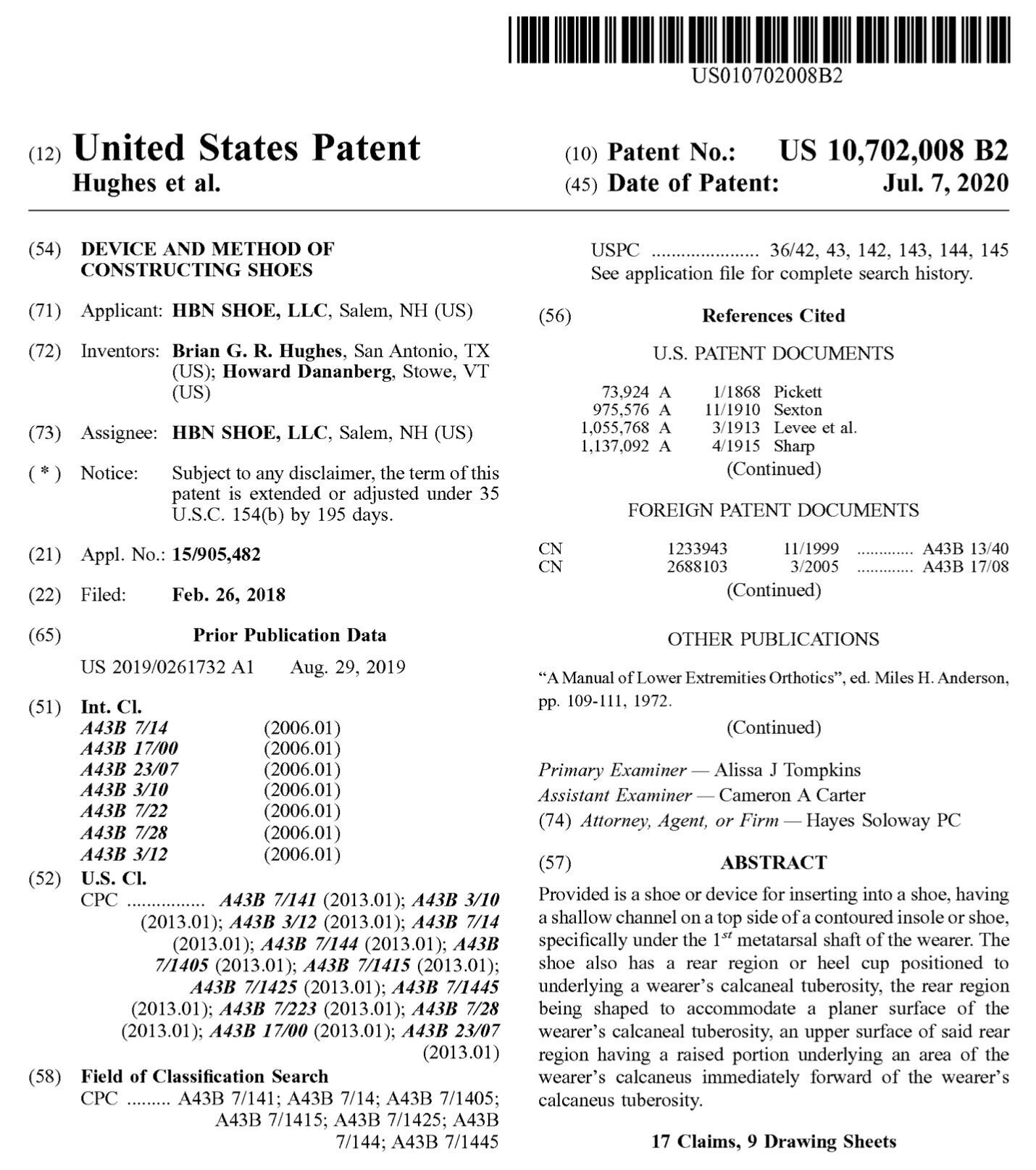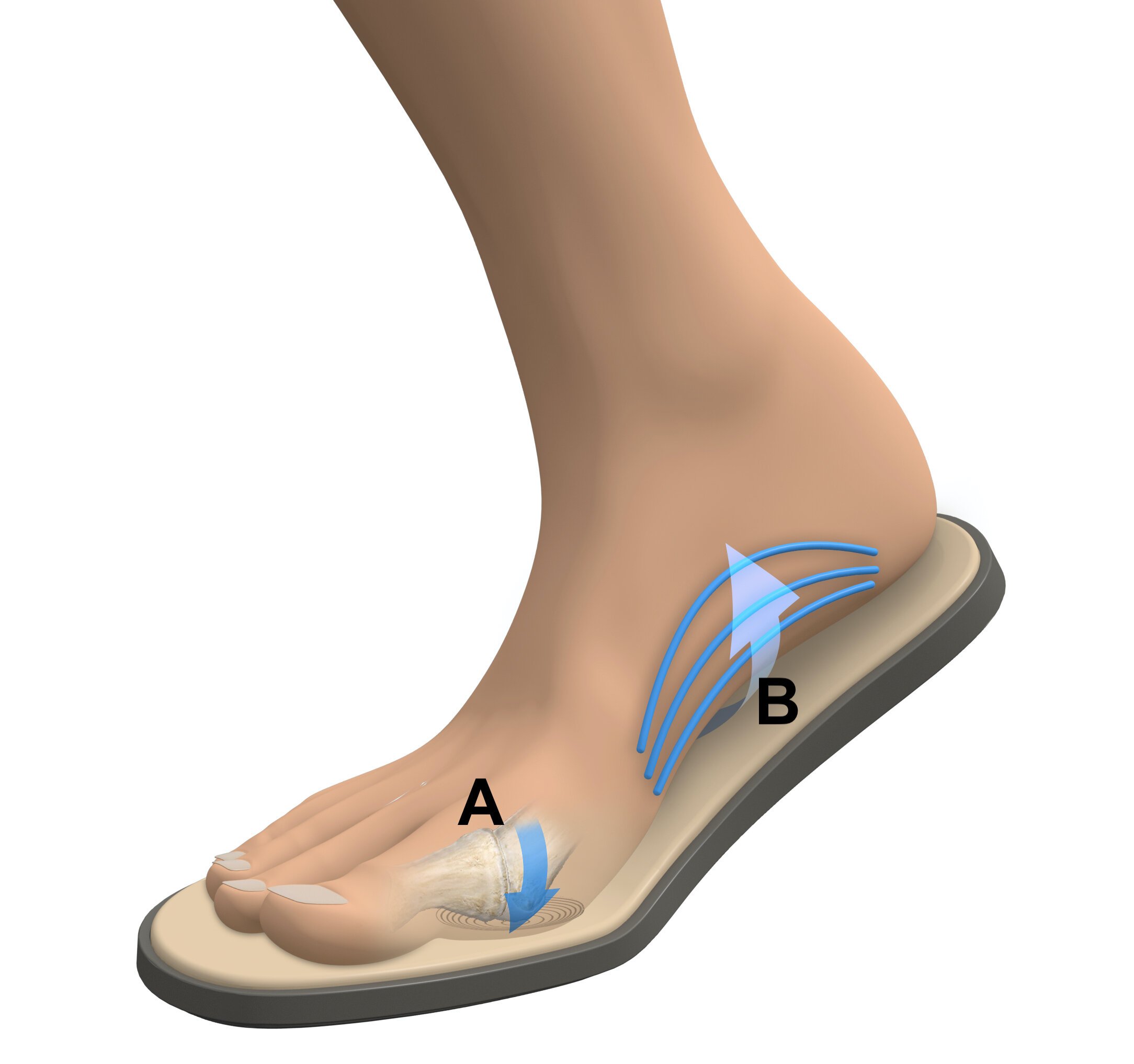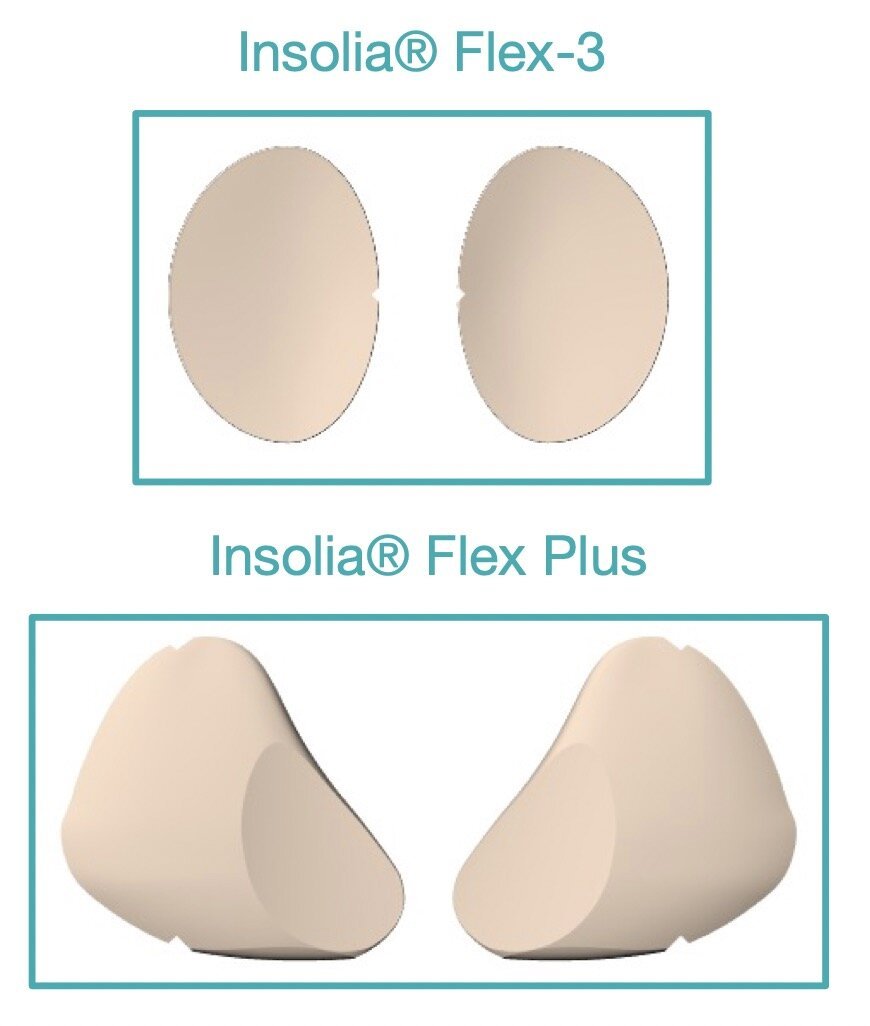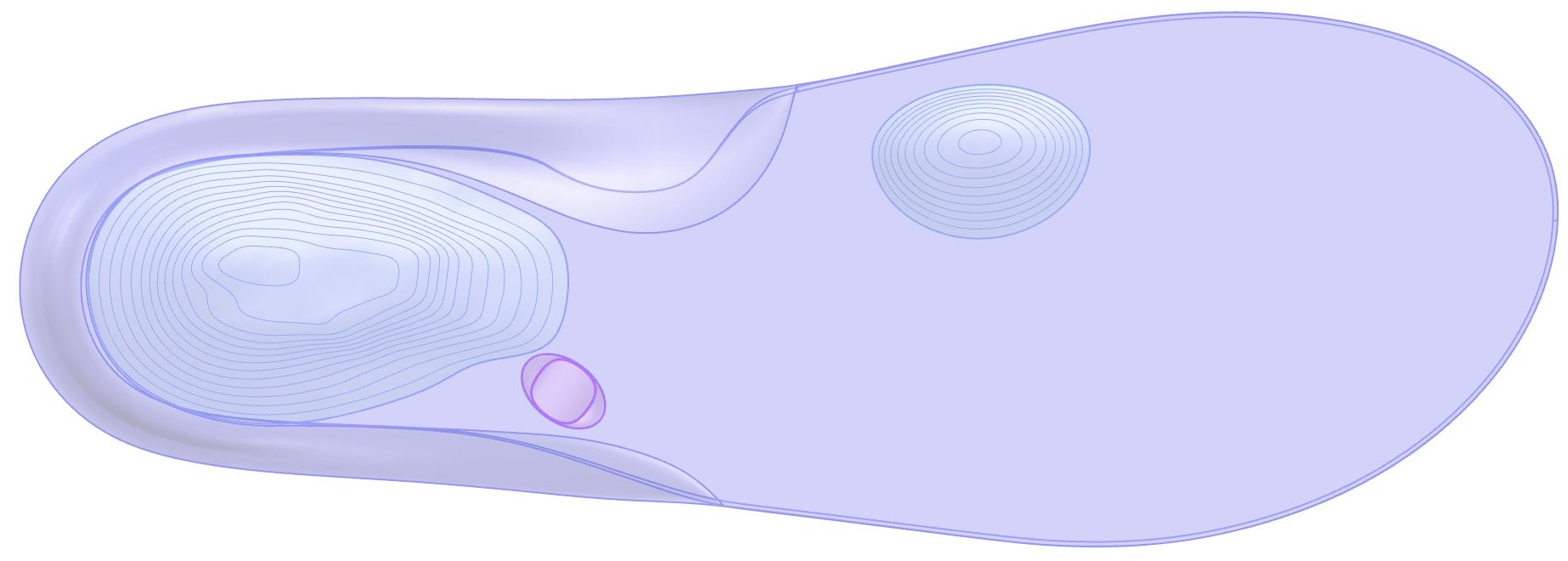A Few Core Technologies - Many Products
We adapt our fundamental inventions to develop many products. Our customers are producing a wide range of OEM implementations of Insolia Flex and Insolia Cradle, from sandals in Bangladesh to high-heels in the UK.
Over 50 million pairs of footwear with Insolia Technologies have been sold.
With the right strategy, a major player in the shoe industry could expand its margins and market share by bringing Insolia Technologies' benefits exclusively to its customers.
HBN Shoe Utility Patent issued by the USPTO on July 7, 2020
Covers Key Insolia Foundation Technologies Through 2038
Insolia® Intellectual Property
Great Footwear Brands Needs Protection From Imitations And Copies
All Insolia Technologies are inventions for footwear applications. We focus on key foot health and body comfort issues to identify the optimal foot position, alignment, support, or flexibility for the specific shoe construction. All Insolia Technologies are based on the structure of the foot and the biomechanics of gait (how we walk). The result is components and designs containing unique formulas and shapes for the inside of the shoe.
We obtain one or more utility patents on all Insolia Products and Technologies we bring to market. We currently hold 34 Utility Patents in the United States, including their international counterparts in Europe, China, Japan, and other markets. Another eight utility patents are pending and in the acceptance process.
Our customers have entered into an Intellectual Property License and Supply & Distribution Agreement that covers their use of any Insolia Product Technologies.
Finally, we have a global network of local patent attorneys who assist us and our customers in the event of any potential infringement.
Insolia Flex, Flex Plus and Flex Max Enhance Forefoot Flexibility and result in Natural, Dynamic Arch Support
Insolia Flex, Flex Plus, and Flex Max
HBN’s Insolia Flex, Flex Plus, and Flex Max technologies deliver the following benefits to consumers in walking or flat shoes:
Enhanced Forefoot Flexibility
Increases perceived forefoot comfort
Enhances biomechanical efficiency
Average 10% reduction in VO2/kg while walking
Natural, Dynamic Arch Support
When we move, the foot’s Arch stores and releases energy while we are walking or running. To do this, the Arch must be free to change its shape dynamically and not be constrained by fixed arch support. The inward rotation of the great toe joint releases it to flex and trigger the Windlass Effect, resulting in Natural, Dynamic Arch Support.
HBN’s Flex Max technology delivers the above in a uniquely functional one-size-fits-many insole.
HBN’s Flex Plus technology delivers the following benefits to consumers in high-heels:
Enhanced stability, standing and walking
Better pressure distribution across the ball of the foot
Insolia Cradle, shown here in a Sandal application, matches the asymmetry of the calcaneus
Insolia Cradle
HBN’s Insolia Cradle technology was developed based on the observation that while heel cups are smooth and symmetric, the calcaneus (heel bone) is asymmetric. The patented Insolia CradleTechnology provides the only anatomically correct calcaneus (heel bone) matching heel cup.
HBN’s Insolia Cradle technology delivers the following benefits to consumers in walking or flat shoes:
Provides an improved platform for balance, stability, and function
An asymmetric profile extended along the medial side reduces the strain on the plantar fascia
Improved standing and moving comfort
HBN’s Insolia Cradle technology delivers the following benefits to consumers in high-heels:
Enhanced balance and stability, standing and walking
Enhanced Weight Shift
Improved standing and moving comfort
Insolia® Foundation Insoles Patent Protection
Insolia Foundation Insole for Men’s Dress Shoe
Insolia Insole Products are protected by two groups of patents.
US 8,166,674, and its International Counterparts cover stand-alone insoles (including molded insoles), which contain Insolia Flex. Expires 2030.
US 10,390,587, and its International Counterparts cover stand-alone insoles incorporating Insolia Cradle. Expires 2036.
Together these patents cover insoles that contain Insolia Flex and Insolia Cradle.
Insolia® Foundation Outsoles Patent Protection
Insolia Foundation outsole for Athleisure Shoe
Insolia Outsole Products are protected by the same two groups of utility patents.
US 8,166,674, and its International Counterparts cover shoes that contain Insolia Flex. Expires 2030.
US 10,390,587, and its International Counterparts cover shoes incorporating Insolia Cradle. Expires 2036.
Together these patents cover shoes and outsoles that contain both Insolia Flex and Insolia Cradle.
Insolia® Heels Patent Protection
Insolia Heel Products are protected by two groups of utility patents and their international counterparts.
US 10,390,587, and its International Counterparts cover stand-alone insoles, sock liners, and shoes incorporating Insolia Cradle. Expires 2036.
US 10,702,008 and its International Counterparts cover Insolia Flex Plus and Insolia Cradle when molded into an insole for shoes. Expires 2038.
Insolia® Flex And Flex Plus Component Patent Protection
Insolia Flex Components are protected by two groups of utility patents.
US 8,166,674, and its International Counterparts cover shoes, stand-alone insoles, sock liners, and orthotics that contain Insolia Flex. Expires 2030.
US 10,702,008, and its International Counterparts cover shoes, stand-alone insoles, sock liners, and orthotics that incorporate Insolia Flex Plus. Expires 2038.
Insolia Flex Max
Patent Issued January 2023
Insolia Flex Max was developed to answer the mass market challenge. Could we develop a low-cost, one-size-fits-most, trim-to-fit insole that would be more than just cushioning? The answer is yes.
Insolia Flex Max - CAD Rendering
Insolia Flex Max was designed to be a PU molded part for strength and thinness.
The closest part has the bottom side up, showing the variable depth of the hexagonal perforations, which reduces the part's mass and cost while providing natural ventilation. The trim lines are visible on the left end of the part. Untrimmed, it’s a US Men’s 13, and the five trim lines take it down to a US M 8.
The furthest part is shown as worn in a shoe. The key is using the mechanism of Insolia Flex Plus, the ramp under the great toe joint, and adjusting it to allow it to function under feet that range over six whole US sizes.
The heel cup incorporates an Insolia Cradle, adjusted to fit the thinnest possible insole.
Insolia Plantar Fasciitis Insole with Cuboid Support
Patent Issued November 2023
This insole was developed to answer the Plantar Fasciitis challenge. Could we develop an insole that would reduce stress on the plantar fascia and reduce the pain associated with Plantar Fasciitis? Comments from users of the “Goldie Lou” sandal we developed around our Insolia Foundation footbed suggested it could be optimized to enhance its ability to reduce the pain associated with Plantar Fasciitis. We went to work.
In addition to optimizing the Insolia Cradle to reduce stress on the plantar fascia, we developed a novel cuboid pad with a groove aligned with the axis of the pull of the peroneus longus tendon. The Insolia Cuboid Pad works in combination with Insolia Flex and the optimized Insolia Cradle to create an insole optimized for relieving Plantar Fasciitis pain.
The Insolia Plantar Fasciitis Insole: The heel cup is an optimized version of Insolia Cradle to reduce stress on the Plantar Fascia. The novel Cuboid Pad is the oval oriented at roughly 45 degrees. Insolia Flex is the asymmetric ovoid under the great toe joint.
Ronaldo - Golden Foot 2009
Insolia Cleats
Patent Application Under Review
A random walk in Monaco led to brass castings of the footprints of some of the world’s greatest soccer players. This triggered an internal discussion about incorporating what we know into an optimized soccer boot.
Dr. Dananberg’s knowledge of foot mechanics and awareness of the types of non-contact injuries led to a focus on reducing the risk of knee damage caused by the foot being unable to rotate due to the cleats locking the foot to the ground.
This locking is driven by three factors:
The inhibition of foot flexing by the locking of the first metatarsal head joint.
The stiffness of the outsole.
The cleat pattern.
Dr. Dananberg’s clinical practise exposed him to many patients who wore cleats that resulted painful symptoms. With his deep understanding of Halux Limitus, he realized that the solution was to grind off the cleat that was located under the first met head, thus enabling the foot’s proper flexion. While this solved the medical problem, it made the cleated footwear difficult to walk in on hard surfaces.
Figure 5 The peak pressure distributions of the four soccer-related movements.
Source: Higher plantar pressure on the medial side in four soccer-related movements Wong P, Chamari K, Mao DW, et al. British Journal of Sports Medicine 2007;41:93-100
doi: 10.1136/bjsm.2006.030668
Our solution focuses on two elements.
First, the flexibility of the forefoot must be restored to allow a proper toe-off.
Then, redesign the cleat under the first met head to eliminate the pressure under the first met head.
The image to the right is from a 2006 study that examined the pressure on the foot in four soccer-related movements. Note the pressure peaks at the first met head in all four motions. Is it any surprise that the foot locks up, given all the pressure up into the first met head?
(You can experience this by pressing your fingers up under your big toe joint in stocking feet - it’s very difficult to lift your big toe when there is pressure under that joint.)
The Insolia Cleat pattern incorporates this knowledge and is designed to focus the power of the foot through the first met head by making the first met head the center of the cleat rotation pattern shown below.
At the same time, we arranged the core cleats around the edge of a dome under the first met head to create an “air gap” under the big toe joint, which allows it to drop and flex.
Dr. Dananberg understood that adding Insolia Flex would enhance the flexibility of the forefoot, allowing the heel to lift, potentially reducing knee stress while increasing stride length and biomechanical efficiency.
Dr. Dananberg also understood that adding Insolia Cradle would stabilize the player’s foot when the heel was highly loaded.
Our innovative approach results in a boot with a hemispherical dome adorned with strategically placed cleats and all other cleats being aligned on radii centered on the dome. This design effectively stops unwanted side-to-side and forward-to-back motion while simultaneously reducing the forces that impede turning around the center of the domed cleat. The outcome? Enhanced player performance and the potential to reduce the risk of non-contact injuries.
Summary
HBN Shoe’s strength is its deep knowledge of the human foot and its engineering focus on developing products that work with standard production methods used in the footwear industry. We have built a robust collection of US and corresponding International Utility Patents that protect this family of innovative products.












